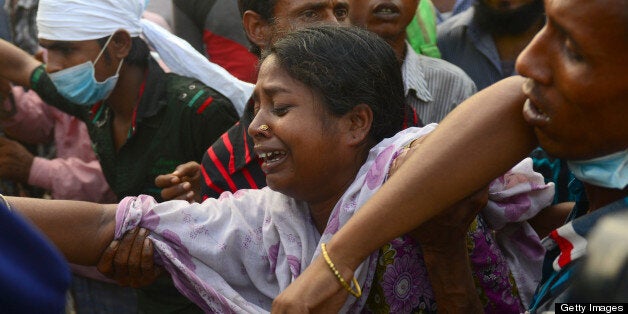
Shahana Akter somehow survived at least four days beneath the rubble of the eight-story Rana Plaza in Bangladesh, the collapsed factory building where nearly 400 people, mostly poor garment workers, have been declared dead.
In the end, four days weren't enough.
Akter's lifeless body was pulled from the wreckage Monday around 4 p.m., after rescue workers located her, abandoned her for dead and then found her alive a second time. The failure to extricate the single mother of a 1-year-old son before she died underscores the plodding pace of the government's rescue efforts in the worst of a string of disasters in the Bangladesh garment industry.
Rescuers discovered Akter and three others clinging to life amid the rubble on Sunday and spent hours trying to dig them out. The three others died that day. After a fire broke out, engulfing Akter's likely escape route, the rescuers assumed she was dead as well. Massive hydraulic cranes and other heavy machinery moved in to start removing heaps of wreckage as the 110-hour search for survivors drew to a close.
In a miraculous turn of events, workers found Akter alive, once again, on Monday morning. But the miracle was short-lived. By the time rescuers actually reached her Monday afternoon, she was no longer breathing.
The slow search for survivors has led to a public fury, particularly among the family members of almost 1,300 garment workers missing since Wednesday, when the building crumbled in Savar, the country's garment hub. [http://bdnews24.com/bangladesh/2013/04/28/relatives-look-for-missing-dead-or-alive]. On Sunday, five survivors were pulled from the rubble.
The suspension of rescue efforts came two days after locals and family members of the missing workers clashed with police and army soldiers, protesting its slow pace. Protesters called it "unstrategic," "cumbersome" and "suffering from serious coordination problems." Responders have said repeatedly that they are trying to rescue the living before recovering the dead, unless they come upon bodies of the deceased.
The victims are thought to be mostly garment workers who were required to come to work, even though large cracks were found in the building the previous day. Rana Plaza housed five garment factories, a bank and commercial shops. Those employed by the bank and the shops did not have to turn up for work on Wednesday. Thousands of people were likely in the building when it came down.
Garment factories outside Dhaka Export Processing Zone in Savar remained shut down Monday for the third consecutive day as workers continued to stage violent protests. Thousands of impassioned workers took to the streets of Savar and Gazipur, another major garment industry area.
More than 200 garment workers were injured as police fired at least 80 rounds of rubber bullets and another 80 teargas canisters to disperse the protesters, Selim Ahmed, a local journalist, told The HuffPost from Savar.
"You cannot even imagine what the workers and their family members are experiencing here," said Ahmed.
Ahmed complained that the authorities show a "mysterious reluctance" to update the official list of the missing and the dead. "On the official list of casualties, the number is dwindling," he said. "In the evening, the number always comes down from what it was throughout the day."
Zafar Imam, director of the Red Crescent Society's volunteer unit, disputed the the government's official death toll of 381. Imam put the number at 392.
"We have received 500 more bags from ICRC [International Committee of the Red Cross], suggesting that the death toll will continue to rise," Imam told HuffPost. He said the ICRC sent the bags after consulting the government. Imam, talking from the scene of the collapse, said it may take a full week to clear the main pieces of wreckage.
The owner of Rana Plaza, Sohel Rana, has declared his innocence. He and the owners of four of the factories have been arrested. Rana, a local ruling-party politician, claimed the garment factory owners made him keep his building open. The factory owners blamed Rana.
Wednesday's disaster is a grim reminder of the dangers faced by impoverished Bangladeshi garment workers, many of whom produce clothing for American consumers. Hundreds of Bangladeshi garment workers die in fires and other disasters each year. The factories are notorious for their disrepair, and the industry faces little scrutiny from government inspectors.
The building collapse comes just months after the staggering loss of life at Bangladesh's Tazreen fire, which claimed more than 110 lives. According to reports, emergency exits had been blocked and windows covered with steel bars, and managers apparently told employees who were aware of a fire to go back to work. Many of the survivors jumped from the burning building.
The ready-made garment industry in Bangladesh accounted for more than 80 percent of the country's exports, according to the Export Promotion Bureau, and the sector thrives on the labor of 3.5 million workers, mostly women, in roughly 5,000 factories.
As the wreckage at Rana Plaza is being cleared, the relatives of the dead are praying and wailing, unsure who to ask about their loved ones. Few seem to be holding out for a miracle. Many only want to retrieve the bodies.
“Give me a trace of my husband," Ratna Begum told bdnews24.com. "If it’s not possible to return him alive, please return his body at least. Now I want nothing other than my husband’s body.”